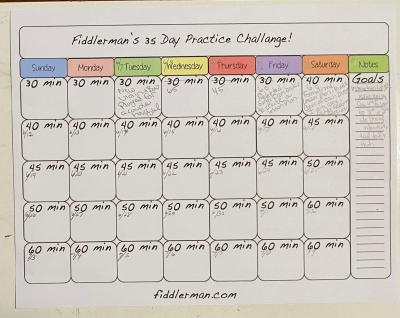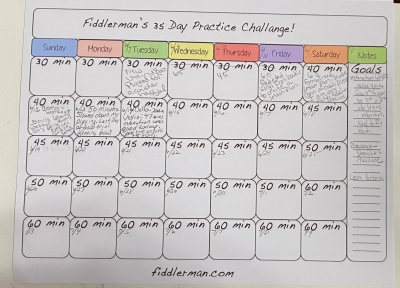Welcome to our forum. A Message To Our New and Prospective Members . Check out our Forum Rules. Lets keep this forum an enjoyable place to visit.
Currently working on getting badges to show up horizontally. Should hopefully figure that out within a week. Thanks for your patience.
 Topic RSS
Topic RSS



 (1 votes)
(1 votes)  Offline
Offline


Good for you!
About the only thing I can say is that when I lost my fingering because of the bad tuner I went back to playing a lot of scales and slowed down to be sure of my finger positions. When I played a score I kept the slower timing to be sure I was putting my fingers down in the right place instead of just slapping them down on any old place on the fingerboard (which I'm still doing - argh!).
Another thing I read on another forum is that playing isn't like anything else we do in life. It requires us to use our hands and fingers in ways we don't normally use them. That means it takes awhile before we can get our fingers to physically do what our heads tell them to do. This is what makes reaching with the 4th finger so difficult.
 Offline
Offline


I think the point of the practicing is to get good intonation after you're done with the 30 days, not already have it before you begin.
Time management... first here's an analogy:
I have "1 square foot" in my house that's totally mine to do what I want with. I put my checkbook, keys, important stuff to do, etc. there. It is absolutely mine and woe be it to anyone who intrudes and puts something of theirs in my 1 square foot. It will end up in the trash without inspection or consideration on my part. I am a complete tyrant in this regard. You can call me nasty names, pout, scream, scold or whatever else you want, but do not put anything in my 1 square foot. Or else. Wifey's purse made the trip to the garbage can once but she learned. She has the rest of the house to organize however she wants to, I have 1 square foot. Fair trade.
Enough with the analogy, back to the challenge - I set aside an hour every day for practice. That hour, like my 1 square foot, is mine and I don't want to be interrupted. Not even by the dog. If the dog demands a walk, someone else better do it before the dog asks me. Same with answering the door, I'm not going to answer the door even if it's the fire dept telling me the house is burning down. It's the only way I can get time to practice because no one else really understands how important this is to me. I can tell them, but they don't really get it. So I lean on the same concept as for my 1 square foot... that 1 hour every day is mine.
Practicing: I start with scales, then maybe an arpeggio or three, then I play something just for playing it. It's only after I play something that I begin to practice. When practicing, I take extra care to perform as perfectly as I can. Make this string crossing perfect and without crunching noises, don't accidentally pluck the string with a finger as I move them, place my fingers exactly where they need to be, and so on. I repeat and repeat and repeat until I can do what I want consistently - or scream in frustration consistently, as long as it's consistently.
I also don't do technique practice every day. Some days I spend the entire hour learning a small piece of new music. Some days it's time spent trying to perfect the playing for the new stuff I just learned. The one rule is that no matter what I'm doing, practice is for learning how to play better, not just playing.
 Offline
Offline


I think if I was going to pick 1 piece from Suzuki Book 2 specifically for intonation improvement I'd choose Brahms' Waltz. Think about it; a waltz has to be smooth, flawlessly played, and resonant.
In my book (newest edition) it's on pg 14 right before Handel's Bouree. Not too long or hard to bow or finger, but the real challenge here lies in perfecting the intonation.
 Offline
Offline


Mouse said
I will google Carenza Strings. Thanks. Great tip to just listen and follow my music. I am grouping and getting the rhythm on my own, but I often times get it wrong and have to relearn, which is harder than learning the first time.Thanks. The tips and comments help me with the challenge.
I did 47 minutes on the violin. Most of it was with the Hunter's Chorus with some D string exercises that use the A on the D string.
I felt like I was bowing better. That by no means means that it was good. Bowing was ignored in lessons and I really need the work on it.
My intonation seemed a tad more consistent today, also.
Cadenza Strings. Search youboob for "Hunter's Chorus", you'll find his slow practice piece as one of the first search results. He's actually a very good player but not an instructor.
I'm no expert (hahahahahahaha!) but I think that a lot of valuable technique is ignored in the beginning when it should be being emphasized. Instead, the emphasis is on keeping the student happy that they're "learning music" by having them play a lot of different pieces. "Look at how much you've learned! You can play Twinkle, Long Long Ago..."
The reality is that sawing your way through piece after piece isn't really learning how to play. And when you finally recognize how poorly you're actually playing, even though you've been told you're doing wonderfully, it's very disheartening. And it's probably a major reason why students quit. Being conned by someone you're told you can trust, hurts deeply.
I do understand that Suzuki had a method to his madness. The earlier pieces are an introduction to music with the playing being almost secondary to learning how to read music. As you progress through the lessons, you learn to read better and understand more of what you're reading. That takes some of the pressure off so you can begin to concentrate on the playing as being the first order of business. I just feel that more emphasis could be placed on better bowing and intonation at the beginning when the student is most ripe for absorbing that information.
Maybe with a live teacher it's different. Maybe when teaching adults it's different. I only know that most of the videos I see, the emphasis seems to be on having the student play as many pieces as they can no matter how horribly they do it.
There has to be a better way.
1 Guest(s)


 Log In
Log In Register
Register Home
Home




















